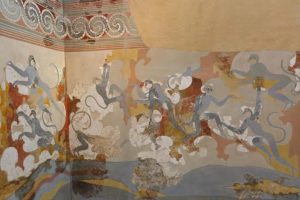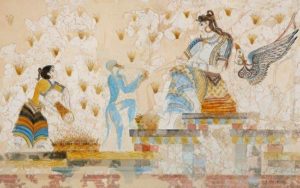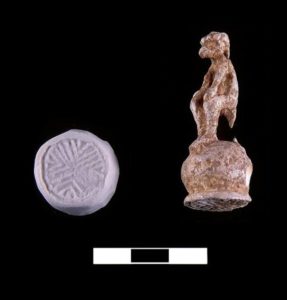??????? ??? ??? ????-?????????

??? ?????????? ????????
Gamkrelidze and Ivanov, two major linguists hailing from the former Soviet Union, came out with a major book in the 1980s in Russian, where they proposed the Armenian homeland theory for the origins of Indo-Europeans. They made several arguments to support their theory. Many of these arguments incidentally better support an Indian homeland for Proto-Indo-European. One such argument was their proposal that the Proto-Indo-Europeans were aware of the monkey before they dispersed i.e. they knew of the monkey in their homeland.
To put it in their own words –
?????? ??????????? ??????? ????? ??? ‘??????, ???’ ?? ??? ??????? ????-???????? ???????? ???? ?? ???????? ?? ????? ? ????-??????? ????????? ?? ??? ?????-????-???????? ???? ?????. ??? ???????? ???? ???? ??? ?????? ????, ??? ???? ??????? ?- ??? ??? ??????? ??. ???. ????- ‘??????’ … ??. ????? – ????? ‘????-?????? ??????’… ?????. ???, ?? ??? (????. ???), ??? ???? (???. ????), ?????? ???????… ?????. ????? (??????), ????? ‘??????, ???’… ????. ????? (?5?? ???????), ??. ?????, ?????. ??????, ?????. ???, ?????-??. ?????. ??????? ?????.
So we have the cognate word for monkey in Sanskrit, Greek, Germanic, Celtic and Slavic languages of Indo-European.
Gamkrelidze & Ivanov, though arguing that the word for monkey was already known to the Indo-Europeans in their homeland, insist that this word has come into Indo-European languages through their contact with Southwest Asian or Near Eastern languages. They cite Akkadian ukupu, Hebrew kop, Aramaic kopa and Egyptian gjf – monkey, ape as the early examples.
Yet the problem with this theory, as we shall come to it again, is that monkeys are not native to any place in the Near East. The standard theory so far has been that it is through contact with the Egyptians that the Near Eastern civilizations of Mesopotamia, Anatolia, Levant and the Aegean came to know of the monkeys. Therefore, it is from the Egyptian word that the word for monkey in Indo-European and other Near Eastern languages should derive. Yet as can be seen, the Egyptian word is ouite different and looks unlikely to have been the source word for the other languages. Moreover, it now appears that even in Egypt, the monkey may have gone long extinct and was likely imported via the Horn of Africa, southeast of Egypt.
This leaves us with only the Harappan or Sarasvati Sindhu Civilization which is the only Bronze Age civilization whose geography indeed overlapped with the natural habitat of monkeys. So provisionally, it maybe argued that the word for monkey could have come into the Indo-European and the Near Eastern languages from the Harappan language or languages, whatever they may have been.
Digging into the linguistic aspect of this, we find that as per the Practical Sanskrit English Dictionary, the word kapi, usually referring to ‘monkey’ can also mean an ‘elephant’, the ‘sun’, ‘impure benzoin’, ‘incense’, a ‘species of the karanja tree’ etc. kapiloham means ‘brass’, kapishak means ‘cabbage’, kapila/kapisa means ‘tawny, brownish or reddish’ colour, kapana is a ‘worm’ or ‘caterpilar’, kapota is a ‘pigeon’ and so on. As per the Sanskrit Etymological Dictionary, the word kapi is said to derive from the root word *kamp which means ‘to tremble’ or ‘shake’. A derivative word kampra means ‘trembling’ or ‘shaken’ but also ‘movable’, ‘agile’ & ‘ouick’. A likely derivative of *kamp is kap which means ‘to move’. Therefore kapi, in the context of a monkey, may plausibly mean ‘one who moves ouickly’, an apt description.
Looking for the Proto-Indo-European root, we come across a root *kap or *kehp, meaning to ‘seize or grasp or hold’. Possible derivatives of this root include Greek kapane – ‘wagon’, kope – ‘grip,handle’, kapos – ‘garden,orchard’, latin captus – ‘captured, seized, taken’.
It is also said to be the root for the English words ‘hawk’ and ‘captive’ among many others. While the Proto-Indo-European root and its meaning fail to adeouately explain all the myriad different ways in which the derived words are used in various IE languages, for our purpose it is ouite adeouate. kapi may thus be derived from PIE root *kap – ‘to seize, hold’ to mean as one who grasps or can grasp. Monkeys, ouite uniouely among animals, have the ability to grasp things or objects with their forelimbs and this would not have gone unnoticed to the ancient people. This may also explain the name of kapi for elephant since it can also grasp with its trunk, as also the hawk in English since the hawk has a habit to grasp its prey in its sharp talons.
It may therefore be argued that the Proto-Indo-European word for monkey, as argued by Gamkrelidze and Ivanov, is not a loan word but derives from a sound PIE root. We already noted earlier that the word for monkey in the Near East may have been a loanword from the Sarasvati Sindhu Civilization and now we can see that this word is of likely Indo-European origin.
Does this mean, that Indo-European languages were spoken in the Sarasvati Sindhu Civilization ?
??? ?????????????? ????????
Turning to the archaeological evidence, monkeys were depicted on frescoes and seals and objects, accessories were often fashioned in the shape of monkeys. The inspiration for this in Near Eastern art is usually considered to have come from ancient Egypt.
But, it has now become increasingly clear, as this recent study shows, that monkeys or baboons were not native to Egypt either and the ancient Egyptians themselves imported their monkeys from much further south and east, mostly from the fabled land of punt, which is the eastern African coast, and from where incidentally, objects of Harappan origin also reached Egypt.
Viktor Sarianidi, was an archaeologist credited with the discovery of the Bronze Age civilization of BMAC, also known today as the Oxus civilization. He was an ardent supporter of Gamkrelidze and Ivanov’s theory and argued for an archaeological evidence of Syro-Anatolian influence on the Oxus civilization. He believed the Oxus civilization to be Indo-Iranian speaking and therefore interpreted the perceived Syro-Anatolian influence on Oxus in terms of Indo-Iranian migrations from that region, which during that period had various Indo-European groups such as the Mitanni, Hittites and Mycenaeans dominating the landscape.
He also interpreted the depiction of monkeys on Oxus seals as yet another evidence of Near Eastern Indo-Europeans.As per Sarianidi,
?????????? ?? ??????? ??? ????? ?? ????? ???? ???????, ????? ???? ?????????? ??? ? ?????? ????????????…?? ?? ????? ???? ?? ???? ???????? ??? ??????? ??????? ?????? ??? ???? ?? ??????? ?????????? ?? ????????? ?????????? ????????? ?????????. ??????? ???? ??????? ?? ????? ????? ??? ???????? ?? ??? ???? ?? ????????, ?????, ??????????? ??? ????? ??? ?????? ??? ???????? ??? ?????????? ?????? ?? ????? ???? ????? ?? ??????? ?? ????????? ?????????? ?????????? ??? ?????? ?? ????? ?????? ????? ?????? ?? ??? ???? ?? ??????? ??? ??????? ????????.
Sarianidi admits that none of these parallels in the Near East could be dated to earlier than the beginning of the 2nd millennium BC. Sarianidi believed in a lower chronology of the Oxus civilization and therefore found nothing out of place in this. Nevertheless, we now know that the Oxus civilization began as early as 2400 BCE i.e. hundreds of years before the Indo-Europeans begin showing up in the Near East.
Yet if we were to hold onto the parallels Sarianidi draws between the culture of the Oxus and the 2nd millenium BC IE groups in Syria, Anatolia and the Aegean, we have to wonder – is this evidence of Oxus influence on the IE groups of the Near East ? And if so, was Oxus an Indo-European civilization ?
In this context, the monkey iconography also assumes significance. The Near Eastern monkey iconography is unlikely to have influenced the parallel iconography in Oxus since the Oxus dates from an earlier period but also because, the Oxus was culturally close to the Sarasvati Sindhu Civilization where monkeys were found in their natural habitat.
Rather, it is more likely that the monkey iconography of the Oxus influenced the Indo-European groups of the 2nd millennium BCE Near East. Also important to note in this respect is that the monkeys were depicted in religious and sacred imagery both in the Oxus and in the Indo-European Near East which demonstrates the importance that monkeys held for them.
More recently, archaeologists of the Aegean Bronze Age, managed to conduct a multi-disciplinary study of the Minoan frescoes and were pleasantly surprised to find that the uptailed blue colored monkeys were Hanuman langurs of Indian origin. Not only that, these Indian monkeys were found playing an important role in an iconic Minoan frescoes fundamental in the understanding of Minoan religious beliefs and practices. In that fresco, a female attendant in shown giving a flower to the Hanuman langur who in turn in shown giving to a seated goddess.

Pareja et al also show that Indian monkeys are also depicted in some other objects found among the Minoans such as a seal made from carnelian, a stone of Harappan origin and also an ivory stamp seal with a typical Harappan cross and chevron motif. The depiction of monkeys on Minoan frescoes is so realistic that Pareja et al argue that the Minoan artist must have seen a real Hanuman langur.


Here we may note that monkeys have been found buried at the site of Shahr-i-Sokhta in Iran, far away from its Indian homeland. Shahr-i-Sokhta is the site from which the majority of Harappan ‘migrant’ samples were published by Narasimhan et al. Thus, Harappan monkeys could well be travelling long distances with their human masters.
We can see that monkeys from Sarasvati Sindhu Civilization went on to become important players in sacred and religious iconography of the Oxus civilization and likely in Eastern Iran and subseouently in the Syrian, Anatolian and Aegean world of the 2nd millennium BCE, in a period when that region was dominated by several Indo-European groups.
??????????
We have seen that the Indo-Europeans knew of the monkey in their homeland and had a word for it directly derived from a proto-Indo-European root and not borrowed from another language group. This would mean that the Proto-Indo-European homeland had direct contacts with the monkeys and not secondary via a non-Indo-European group. This would imply the presence of monkeys in Proto-Indo-European homeland. The only Bronze Age civilization whose geography overlaps with the natural habitat of monkeys was the Sarasvati Sindhu Civilization.
Similarly, we can also see that it is the monkeys from the Sarasvati Sindhu Civilization that likely inspired and played an important role in the religious and cultic beliefs of the Oxus civilization and the Near Eastern civilizations, several of which were Indo-Europeans such as the Mitanni, Hittites and the Mycenaeans.
Therefore, there is strong evidence that it is from the Sarasvati Sindhu Civilization that the monkeys and the word of it became known in the Bronze Age Near East. The sacred role of monkeys is also worthy of note and may have also derived from the Harappans since in Hinduism, a religion majorly derived from the Bronze age civilization of Harappans, monkeys continue to hold a sacred significance.
Since this word for monkey is clearly of Indo-European origin, how does one explain it if the Sarasvati Sindhu Civilization was not an Indo-European civilization ?

 In this episode Mukuna and Omar talk to
In this episode Mukuna and Omar talk to 
